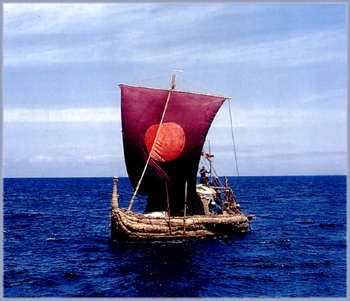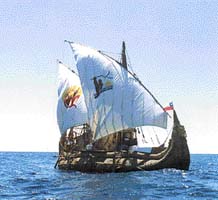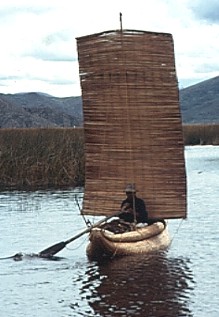"Atlantis: the Andes Solution"
"The Atlantis Trail"
"Atlantis: Lost Kingdom of the Andes"
"Atlantis and the Persian Empire",
"Tiwanaku: a City Lost in Time"
Reed boatbuilding is an occupation which has a long tradition and is found kept alive today by the Aymara and Uru boatbuilders on Lake Titicaca, high in the Andes of South America. Small vessels are also still built along the Pacific shores of Peru for coastal fishing. In Africa, reed boats are still in use upon Lake Chad whilst reed boats have a long tradition in what is now southern Iraq where in ancient times they reached giant proportions of some 495 feet according to Thor Heyerdahl.
Reed boatbuilding seems to have had what one might call a popular revival, beginning in 1969 with the construction of Feathered Serpent by Gene Savoy in Peru and at the same time by an Atlantic crossing by Thor Heyerdahl in a reed boat called RA1 - this vessel was built in Morrocco by boatbuilders from lake Chad but the voyage was abandoned near Barbados.
Heyerdahl followed this up with RA2 in 1970 when he got boatbuilders from Lake Titicaca to fly over to Morrocco and build the boat for him which crossed the Atlantic with more success.
Since then there have been various reed ship constructions with differing degrees of success, vessels in ancient Iraq were formerly coated in a special mixture of bitumen, pitch and oil but no modern boatbuilders seem to have followed this practice, equally, ancient Egyptian vessels are shown with a special cord connecting the prow to the stern for reasons of support, but again this practice seems never to have been followed leading to extra stress and sometimes disintegration of the vessel. Another factor leading to the disintegration of the stern of the vessels is the use of steering oars lashed to the side of the vessel instead of guara boards (dagger boards) inserted between the hulls. Consequently the stress of the steering oars on the rear of the vessel often makes the stern fall off.
The reed ships typically consist of two large reed bundles lashed by a continuous cord to a smaller central bundle of reeds. The design might be improved, especially in larger vessels, by using a timber or balsa raft between two hulls (joined at prow and stern) which would strengthen the vessel and also allow the cabin to be inserted lower down within the overall vessel. Guara boards could then be inserted through the timber raft so the vessel could be steered by raising and lowering the guara boards thus altering the centre of effort of gravity and effort on the sails and the use of three masts would also aid the steering of the vessel by raising and reefing or lowering the forward and rear sails respectively.
Modern reedships seem to be build to a reduced size in order to facilitate construction in Bolivia and transportation either by shipping crate or low loader, but for tranoceanic voyages, it would be better if the vessels had a minimum size of around 100ft (30 metres) and were built at suitable departure points e.g. the mouth of the Rio de la Plata (River Plate) for a voyage under Southern Africa and up to the Persian Gulf or the mouth of the river Orinocco for travel to the Mediterranean. They could be constructed from reed gather locally at these sites, and the Venezuelan site also has the advantage of a natural lake of pitch at Guanoco, near the Guanoco River, itself near the Gulf of Paria and the delta of the Orinocco. Incidentally, the river Orinocco is connected to the river Amazon by a natural canal called the Cassiquiare canal.
It is clear that more work needs to be done on the design and construction of the vessels to make a true seagoing ship and experimental and traditional vessels continue to be built providing modern examples of this fascinating vessel.
Ra I
RA II
Built: Thor Heyerdahl, Safi, Morocco; 1970.
TIGRIS
Built: Thor Heyerdahl, al-Qurna, Iraq; 1977.
URU
CHIMOK
MATA RANGI I
ABORA I
Mata Rangi II
QALA YAMPU
VIRACOCHA I
MATA RANGI III
Mati Rangi III travelled the length of the Morrocan coast, stopping in Tangier, Rabat, Casablanca, Mohamedia, Agadir and finally, Sidi-Ifni, the home town of Kitín Muñoz.
The stay in Morrocco lasted eight months, during which Kitín Muñoz was received on various occassions by SM el rey Mohamed VI who named him Honorary Consul.
The Spanish adventurer and navigator Kitín Muñoz and his team left the Moroccan port of Sidi Ifni on December 2nd aboard their ancient-style reedboat "Mata Rangi III". Their aim has been reported as to cross the Atlantic Ocean within some 50 days and to keep sailing in the Caribbean Sea in order to test the ultimate strength of this sailboat built according to a Pre-Colombian technique. Behind this new challenge for Kitin Muñoz, inspired by Thor Heyerdahl, was the will to prove the maritime capabilities of ancient peoples and their consequences in the intercontinental population migrations.
ABORA II
VIRACOCHA II
Abora III
Kota Mama I
KOTA MAMA II
Kota Mama III
MEGAN
VIRACOCHA III
Reed Boatbuilding in Bolivia by Porfirio Limachi
In the construction of reed boats it is important to note that this is a traditional craft handed down from generation to generation. Therefore there do not exist lines plans or drawings in the sense of constructing wooden boats or in modern materials such as fibreglass.
The charm of the boat lies in the fact that it is constructed by traditional methods depending largely on the skills of the builder.
CONSTRUCTION PROFILE OF A REED BOAT (TOTORA)
Different steps for construction:
1 It is important to select the best totora stems for weaving the fabric which is also part of the cover of two cores which will make the boat. The totora has to be complete in unbroken stems for the laying and have a regular thickness.
2 Once we have the right totora, we proceed to make the longitudinal cores, weaving the reeds so each stem can trap the ends of the adjacent stems.
3 In each section, the plaiting of the weave has a knot which joins the stems of the totora.
4 After the weaving is done, each core will be laid and they will be used as the bases for the main body of the boat. Then, on top of the main cores, we cover with several layers of totora reeds always in a longitudinal direction, which are tied with provisional binds which are later taken off. When the cores take the shape of two oval "sausages", they are ready to be covered with what is in fact an extension of the laying of the main bases.
5 Fabric of the covers or outer layers; those layers are woven with reeds especially selected and we follow the same process as the one used for making initial main bases.
In this way, the outer covering of the main hulls comprises especially selected reeds.
6 Constructing the central core. Afterwards, we proceed to build a smaller third core which will be installed in the centre between the two main hull cylinders, and will be used to join the two main bodies in the construction of the boat.
7 Joining the two hull cores; joining of the two main bodies comprising the hull with the central core is done using a system of plaited ropes using straw which grows in the Bolivian Altiplano. This rope is wound as a spiral in order to fasten the two main bodies to the small body or central core from end to end. This operation must be done with the two main bodies of the reed boat.
8 Drainage of the boat. When doing the joining of the two bodies and arriving at the bow and stern, we leave openings for the boat to drain.
9 Adjusting the hull bodies. When the process of assembly is over, it is time to adjust the ropes containing the body of the boat until the central core disappears completely, only leaving free and with the rope loose, the bow and the stern, these will be plaited little by little until we make these ending points.
During the process of adjusting the spiral ropes, the reed boat must be kept wet or humid.
10 Curving; the curve of the two ends, bow and stem, is obtained with an upside-down Y-shape support.
11 Compression of the hull bodies and adjustment of the ropes: This operation has to be done again and again in order to have the hull bodies very well compressed.
In this step, it is not only necessary to tension the ropes, but also to give uniformity to the surface of the boat. This is obtained by hitting the two hull bodies with an oval rock while doing the adjusting of the ropes.
12 Pre-finished boat: when the boat is finished with the two ends and the hulls very well compressed, we proceed to build two small reed cylindrical rolls which will be used as supports or sides, tied to the main hulls of the boat.
13 The side cores or bulwarks; are tied to the sides of the boat with a rope in spiral form which is bound to the two main bodies.
14 The boat is then finished and can be floated in the lake.
15 The boat is then equipped with accessories necessary for voyaging, like a sail, which can be made out of reed or fabric, two wooden (eucalyptus) masts which support the sail, and ropes or cords to manage the sail during use.
Use of material (prime material - totora reeds)
Biological aspects of totora (SCHOENOPLECTUS TATORA)
In Lake Titicaca there are many clusters of species of vascular plants called totoras.
The totora has constituted one of the prime materials for boat building since prehispanic times. Some of these ancestral plants have also been used as food by the inhabitants, for craftwork which is of high cultural value, for health, for roofing of houses, daily feed for cattle, fuel for cooking fire and other uses.
An important historic factor to take note of has been the construction of gigantic reed boats for the purposes of expeditions and exploration, such as the expedition of the boat Ra II with which Thor Heyerdahl crossed the Atlantic in 1970.
Actually the totora is of great socio-economic importance for the population of Lake Titicaca and is also of great scientific interest for investigators.
Taxonomical classification:
Class: Monocotiledoneae
Order: Cyperales
Famliy: Cyperacea
Genus: Schoenoplectus
Species: Schoenoplectus tatora
Morfological characteristics:
Totoras are aquatic plants whose erect stalks support photosynthesis, they are rugged plants even though their roots are embedded, their leaves are set out in three vertical lines in such a manner that their base forms a closed vein surrounding the stalk, the flowers are small and marked by herringbone scales.
Living patterns:
The totora develops at a depth of between 2 to 5 metres approximately; they stick up out of the water at a short distance from the shore, their stalks reach out of the water to a height of 3 to 4 metres.
Socioeconomic importance of the totora:
The totora has many uses, the white parts of the inside of the stalk are soft and tasty and are eaten like fresh vegetables, also for feeding cattle and sheep and are a remedy for kidney failure. In fact it is a fodder plant constituted mainly of photosynthetic stalks. It is digestible and contains a high level of proteins. Its exploitation is organised in private plots. The increase in production and sowing methods depend on the depth of water. The stems which are found on the water surface are dried by the effect of the sun and wind which gives them a yellow colour, this type of totora is used in handicrafts, mattresses, mats, roofs for houses and construction of reed boats. Totora is also a habitat for numerous fish and aquatic birds and aids the ecology and beauty of the lake as well as purifying the water.
The building of reed boats in totora on the island of Suriki is traditional, the technique used is thousands of years old and constitutes ancestral knowledge.
Thor Heyerdahl gave this opinion on this technique of boatbuilding: "But they knew how to create boats from reeds and with a perfection which no engineer, naval architect or archaeologist of our modern world could emulate." (Expeditions of Thor Heyerdahl, pg 292) talking of the Aymara boatbuilders who built the Ra II with which the explorer crossed the Atlantis and others….
Compiled 28th February 2010 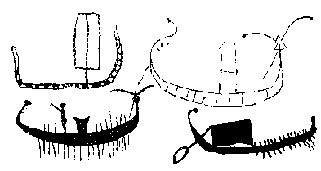
pre-dynastic
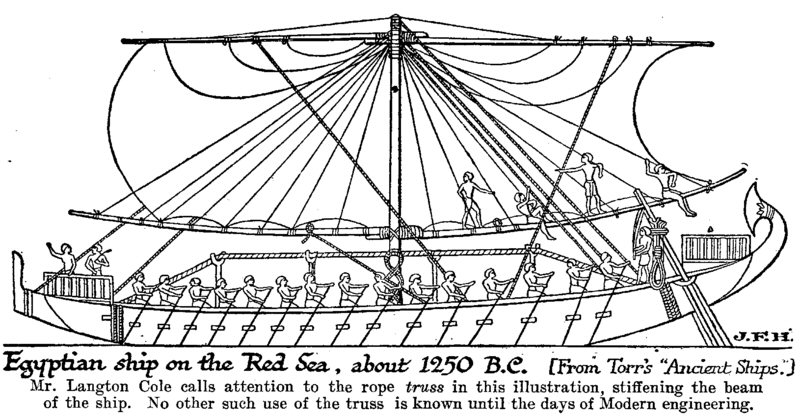
FEATHERED SERPENT
Built: Gene Savoy, Huanchaco, Peru; 1969
Reed ship (1m) Length: 36ft (11m). Hull: totora reed Compliment: 4 Design: traditional (?)
Like Thor Heyerdahl, American explorer Gene Savoy had an intense interest in the prehistoric civilizations of Peru. Rather than reaching across the Pacific from South America, Savoy was convinced that the Andean empire of the Incas and the Mexican empire of the Aztecs had had regular contact along the western coasts of South and Central America. In 1961, Savoy “observed a petroglyph etched on a rock in the Jequetepeque Valley of northern Peru. It was a Mexican hieroglyph for gold” (Savoy 1974, 17). Observing this and other similarities, Savoy concluded that a regular prehistoric trade had clearly existed between the two culture areas, and that that trade was conducted over the water.
To demonstrate his belief, Savoy set out in the spring of 1969 to build a double-hull ship of totora reed and sail it from Peru to Mexico. Savoy named his proposed vessel Kuviqu, his own contraction of the names of Viracocha, Quetzalcoatl, and the Maya figure Kukulcan. The Kuviqu, or Feathered Serpent, as it was more often referred to, took shape at a dockyard in the small fishing village of Huanchaco. The final fitting out of the Feathered Serpent took place at a naval dockyard at Salaverry, eighteen miles south of Huanchaco. The twin hulls were attached to the decking, and the cabin built and the double mast stepped.
On April 15, 1969 crew members settled into the Feathered Serpent as it was towed to sea and let go. The raft was taken by the Peruvian Current and carried northward. After nine days at sea and two ashore, the raft drifted into the port of Talara, some 350 miles north of its starting point at Salaverry. There Savoy was accused of trying to transport antiquities out of Peru. The raft was detained briefly, then sailed out of Peru and into Ecuadorian waters. On May 6, 1969, the raft was towed into Manta where Savoy requested that the raft be lifted out of the water so he could inspect the wear on the totora reed. Then the Feathered Serpent was accidentally dropped from fifteen feet in the air. The shock of impact broke the vessel’s back, canted the deckhouse, and collapsed the double mast. In no position to repair the damage at this stage of the expedition, Savoy transformed what had been a sailing reed boat into a true drifting cargo raft.
The expedition returned to sea on May 14, drifting northward toward the equator. The Feathered Serpent began a meandering drift northward in search of the current that would sweep it across the Gulf of Panama. The current picked up the battered reed raft on June 14, and propelled it northward. Savoy anchored his reed boat for the last time, in Panama Bay. Savoy himself went off for a month of exploring Maya ruins, and when he returned, he discovered that a storm had blown his raft to sea. He never saw his Feathered Serpent again. At one point, all Savoy’s cameras on board were subsequently waterlogged, destroying his visual record of the expedition.
Savoy, ON THE TRAIL OF THE FEATHERED SERPENT
Bobbs-Merrill Company, Inc. ©1974
Built: Thor Heyerdahl, Safi, Morocco; 1969.
Reed Ship (1m) Length: 45ft (13.7m). Hull: papyrus reed Compliment: 8 Design: traditional
Intrigued by the strong resemblance between various aspects of ancient Egyptian and pre-Columbian culture, Thor Heyerdahl set out to demonstrate that the sources of New World technology and belief could have come from across the Atlantic. A crucial point of similarity was the design of reed boats shown in Egyptian tombs and found on Lake Chad, the Andean Lake Titicaca, Easter Island, and Polynesia to which he had sailed in the balsa raft Kon-Tiki in 1947 across the Pacific. Heyerdahl hired Chadian reed boat builder Abdullah Djibrine and two Buruma colleagues to build a kaday from papyrus cut on Lake Tana, the source of the Blue Nile in Ethiopia. The design was worked out in consultation between Djibrine and Björn Langström, a Swedish authority on ancient Egyptian boat design.
The finished Ra—named for the Egyptian sun god—made entirely of papyrus and rope was taken by truck and ship to the Moroccan port of Safi where she was launched. The polyglot crew consisted of Heyerdahl, Djibrine, Yuri Alexandrovich Senkevich (Soviet Union), Norman Baker (United States), Carlo Mauri (Italy), Santiago Genoves (Mexico), and Georges Sourial (Egypt). Provisions for the voyage were carried in 160 amphorae made according to a 5,000-year-old example in the Cairo Museum. The voyage began on May 25, 1969. Although Ra made it most of the way across the Atlantic, covering about 60 miles a day (2.5 knots), the crew were forced to abandon Ra near Barbados, because much of the stern had sagged and the raft was breaking up.
Heyerdahl, THE RA EXPEDITIONS
Doubleday and Company, Inc. ©1971
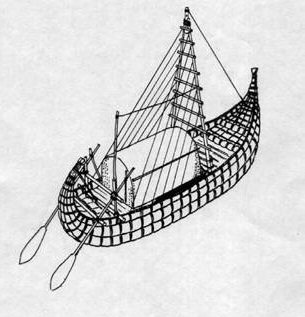
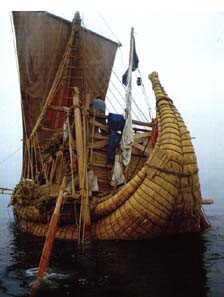
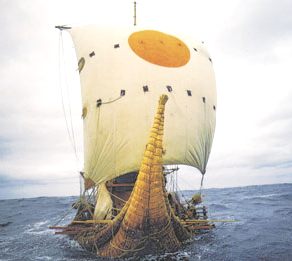
Ra II
Reed Ship (1m) Length 39ft breadth 16ft depth 6ft (11.9m × 4.9m × 1.8m). Hull: papyrus reed Compliment: 8 Design: traditional
Convinced only that he had chosen the wrong design, Heyerdahl arranged to build Ra II, a Moroccan madia whose design more closely resembled that of the reed rafts on Lake Titicaca. Four Aymara reed builders from Bolivia were brought to Morocco for the project, which again used reeds from Lake Tana. Though 20 feet shorter than Ra I, Ra II carried eight crew, Madanni Ait Ouhanni (Morocco) and Kei Ohara (Japan) sailing in place of Djibrine. The second attempt, setting out on May 17, 1970, was a success, the voyage from Morocco to Barbados being completed in only 57 days.
Heyerdahl, THE RA EXPEDITIONS
Doubleday and Company, Inc. ©1971
NATIONAL GEOGRAPHIC
January 1971, Volume 139, Number 1

Tigris
Reed ship (1m). Length: 60ft (18.3m). Hull: Berdi reed bundles. Compliment: 11.
Named for the Mesopotamian river along whose course the Sumerian civilization flourished about 3000 BCE, Tigris was built by Norwegian explorer Thor Heyerdahl, who intended to prove that Sumerians and their contemporaries could have navigated such craft over long distances. Heyerdahl had made previous similar investigations in Kon-Tiki and Ra II. Modeled on early renderings of seagoing craft from the Persian Gulf and Egypt, Tigris was built by so-called Marsh Arabs of Iraq's Shatt al-Arab, who bundled the reeds, and Aymara Indians from Lake Titicaca, Peru, who turned the reed bundles into "a sickle-shaped ship that would neither capsize nor lose its shape in the ocean waves." She carried a single mast from which were set two square sails.
Launched in November 1977, and flying the flag of the United Nations, Tigris had difficulty navigating through the Persian Gulf owing to unseasonably adverse winds and the tremendous amount of tanker traffic and offshore oil wells that had to be avoided. The first port of call was the island country of Bahrain, which many archaeologists have identified as Dilmun, the great seaport of the Gilgamesh epic. From there she sailed south and east out of the Strait of Hormuz before heading west along the coast of Oman. Landing at Muscat, the Tigris crew were among the first westerners to visit the remains of the ancient copper mining center at Shohar. After heading for Africa, a change in the wind enabled them to sail for Pakistan's Indus Valley, the site of an ancient civilization centered on Mohenjo Daro and Harappa that evidently traded with Sumer. From there they sailed west until they passed through the Bab al-Mandeb at the mouth of the Red Sea and on to Djibouti, where they arrived in March 1978. At Djibouti, on April 3, 1978, they burned Tigris to protest the conflicts that had prevented them from landing in North or South Yemen on the Arabian Peninsula, or in war-torn Somalia or Ethiopia. Their five-month, 4,200-mile voyage through the Persian Gulf and across the Indian Ocean had proven both the navigability and the extreme seaworthiness of such reed craft and "shown that the ancient people in Mesopotamia, the Indus Valley and Egypt could have built man's earliest civilizations through the benefit of mutual contact with the primitive vessels at their disposal five thousand years ago."
Heyerdahl, THE TIGRIS EXPEDITION: IN SEARCH OF OUR BEGINNINGS
Doubleday and Company, Inc. ©1981
NATIONAL GEOGRAPHIC
December 1978, Volume 154, Number 6
Built: Kitín Muñoz, Lima, Peru; 1988.
Reed Ship (1m) Length: 65.7ft (17m). Hull: totora reed Compliment: 5 Design: traditional
Thor Heyerdahl’s American Indians in the Pacific (1952) compiled a sizable mountain of evidence that pointed toward the possibility that pre-Incan mariners in reed boats had once attempted to cross the Pacific Ocean from South America to the islands of Polynesia. Not until thirty years later, however, with his Tigris expeditions, did Heyerdahl learn exactly how long a reed ship, constructed from properly harvested reeds, could stay afloat. Beginning in the late 1980s, a new generation of expeditions sought to use this knowledge to test the limits of the reed boat on experimental voyages from South America into the Pacific.
In 1988, a Spanish explorer named Kitin Muñoz, who has referred to himself as the “spiritual son of Thor Heyerdahl” (Reuters, April 27, 1997) set out to build a reed boat and drift all the way to Tahiti on it. The Uru was similar in size to Ra II but constructed of totora reeds instead of papyrus. It was built by the same reed-boat builder, Paulino Esteban, who along with other Aymara Indians had built Heyerdahl’s successful transatlantic reed vessel.
On June 29, 1988, Muñoz set out from Lima, Peru, and in seven weeks crossed the eastern Pacific to a landing in the Marquesas. Muñoz had every intention of continuing his voyage to Tahiti, but a severe storm set the reed boat adrift until its rescue by a Tahitian fishing vessel in October. Muñoz and his crew were brought ashore, and the expedition ended on October 16, 1988. He had shown that a reed vessel could in fact survive the nearly two-month voyage from South America to the nearest islands of Polynesia.
Aula de el Mundo, EXPEDICION URU
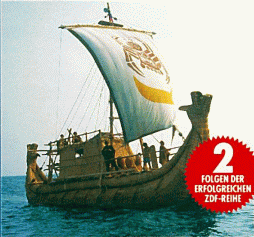
Chimok
Built: Pimentel, Peru; 1988.
Reed Ship (1m) Length: unknown. Hull: totora reed Compliment: 0 Design: traditional
While Heyerdahl was involved in the excavations of the coastal pyramid complex of Tucumé in Peru beginning in 1987, several explorers approached him for advice and assistance in getting their drift expeditions under way. One of these was a German film crew who sought to sail a reed ship from a port in northern Peru to the Galapagos Islands. They would thereby provide an experimental linkage between pre-Incan cultures of the coast of South America and the pre-Incan pottery shards found in the Galapagos by Heyerdahl and Arne SkjolsvoId during an expedition to the archipelago in January 1953.
Paulino Esteban, who had helped to build Heyerdahl’s Ra II and Tigris, and Muñoz’s Uru, arrived in the Peruvian fishing village of Pimentel to construct the Chimok from totora reeds. Heyerdahl suggested to the film crew that they try to build a double-stern reed boat, one that was of Moche design.
The Chimok, with its dragon heads rising from the double stern, was launched from the beach at Pimentel in front of a large crowd, with Heyerdahl doing the honors of christening the huge vessel. Almost immediately, the Germans, along with Esteban and a local Peruvian fisherman, sailed into a storm, but not one of nature’s creation. As the reed ship floated perfectly atop the waves, the crew received word that tensions along Peru’s border with Ecuador had escalated almost to the point of war. The Ecuadorian government insisted that the Chimok sail into the port of Guayaquil and obtain proper clearance papers before attempting to sail for the Ecuadorian-controlled Galapagos.
In film of the voyage, a narrator relates that the Ecuadorian government threatened to send a warship after the reed boat if it did not turn around. The crew speculated that the Ecuadorian government resented the Chimok expedition specifically because Heyerdahl had harvested the balsa logs for Kon-Tiki in Ecuador yet sailed from Peru. As Heyerdahl’s archaeological teams were unearthing evidence of a direct connection between the birdman cult on Easter Island and the Lambayeque culture dated to roughly 1100 C.E.. in pre-Incan Peru, the reed boat Chimok was being abandoned in Peruvian waters because of the war, and allowed to drift on alone into the Humboldt Current. No satellite tracking of the Chimok was apparently possible before it was abandoned, so it is not known for how long nor how far the reeds drifted before they became waterlogged and sank.
Heyerdahl, PYRAMIDS OF TECUMÉ: THE QUEST FOR PERU’S FORGOTTEN CITY
Built: Kitín Muñoz, Easter Island, Chile; 1996.
Reed Ship (1m) Length 131ft (40m) Hull: totora reed Compliment: 11 Design: traditional
The 11-man crew included one Hawaiian, two Tahitians, two Maori, 2 Aymaras, three Rapanui, and one Spaniard— Kitín Muñoz, the leader of the project.
Muñoz explained: "With this voyage I would like to demonstrate that many of the parallels that exist between different cultures and people, that today are attributed to artibrary causes, had their reason in the voyages that had crossed seas and oceans in remote times and before the European expeditions of the 15th century."
He said, "In the first phase, the ship will travel through all the Polynesian islands such as Mangareva, Tahiti, Bora Bora, Tonga and Fiji reaching finally Australia. There the boat will be taken out of the water and dismantled to permit the reeds to dry, an operation that will take about two months."
On May 6th, the voyage began. The boat was scheduled to go first to Pitcairn, with the ultimate stop at Tahiti. On the 8th of May, two stowaways were found: Sergio Tuki Hito and Ricardo Hito had hidden themselves in the hold of the boat. These two brought the number of persons on the boat up to 13, and some noted that it was an unlucky number.
By the 12th of May, radio contact was lost. Four days later word came that Mata Rangi was 140 miles northwest of Rapa Nui. They had expected to have traveled 600 miles by that time, and thus declared that they would not stop at Pitcairn but head directly for Mangareva.
On the 21st of May, it was reported that, according to a satellite telephone communication received from somewhere in French Polynesia, the boat was still on course, but with a broken mast. The Chilean training ship Esmeralda was sent to offer help. They found her lying somewhat submerged and with water coming in the hole where the mast had been.
Then on May 24th the news came that Mata Rangi had split in two and the crew had taken to lifeboats tied to the sinking boat. They were rescued by the Stray Dog, a sailboat that had been visiting Rapa Nui but which left to join in the rescue effort. Mata Rangi was only 185 northwest of Rapa Nui; the boat had been in the water for a mere 20 days.
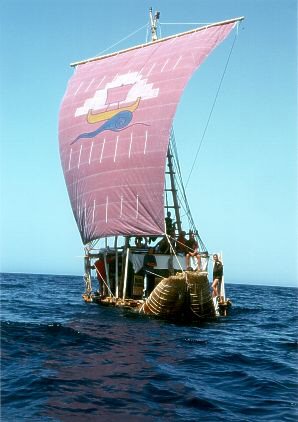
Abora I
Built: Dominique Goerlitz, Alghero, Sardinia; 1998.
Reed Ship (1m) Length 40ft breadth 13ft depth 5ft (12m × 4m × 1.5m). Hull: vulgar reed Compliment: 13 Design: traditional
The progress of modern archeological research in the Mediterranean and Atlantic region has resulted in a new theory of cultural development of mankind. New discoveries on the larger Mediterranean and Canary islands have indicated that early cultural centers had contact with each other over thousands of miles of the sea. But these claims can not be proven by archeological discoveries only. These claims need experimental proof, which shows that our ancients did possess the technology to build steerable vessels 6000 years ago. Such vessels should have been able to navigate in sufficient distance to the coast line across the wind.
The first part of the journey was going from Alghero along the northern coast of Sardinia. After two stopovers in Castelsardo and Santa Teresa, Abora I reached Bonifacio on the southern corner of Corsica. From there the crew sailed on to Bastia (northern Corsica). A strong current with southern direction forced the crew to sail very close to the coast, to be ready for a fast anchoring, in the case of slow wind. The last part of the expedition was going to Elba and then to Piombino, where the expedition ends.
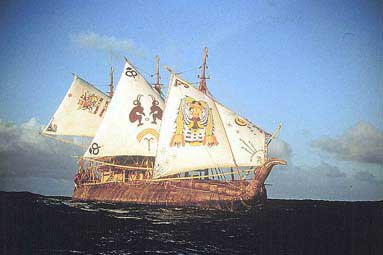
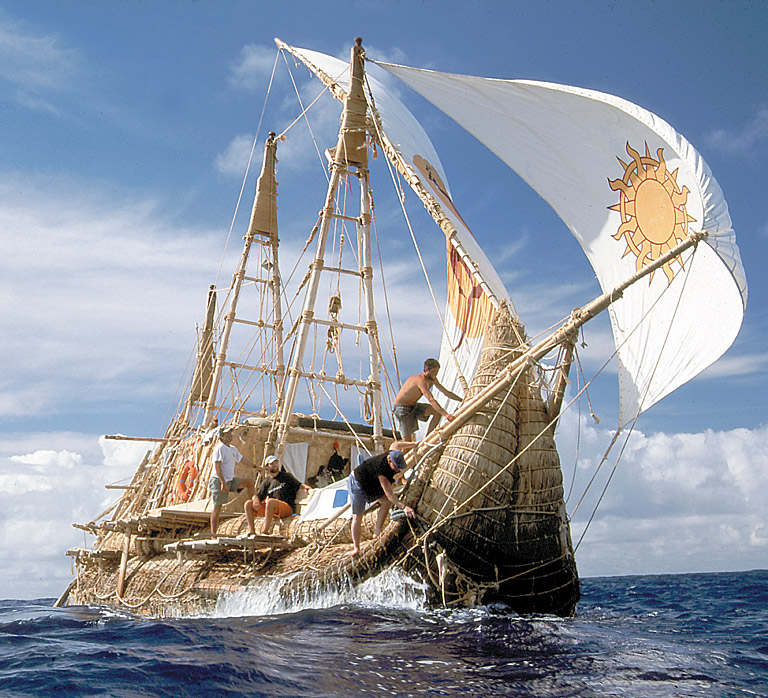
Mata Rangi I and Viracocha II
Built: Kitín Muñoz, Arica, Chile; 1999.
Reed Ship (1m) Length 95ft (29m). Hull: totora reed Compliment: 9 Design: traditional
The Mata Rangi II, a 30-meter reed boat, set sail Sunday from the northern city of Arica in what observers have described an attempt to prove that pre-Inca civilizations traveled by sea to Asia. This time Muñoz aims to reach Asia or the Micronesian Islands.
The Mata Rangi II expedition is the brainchild of Spanish adventurer Kitín Muñoz, a 40-year-old bachelor who has never had any formal training in navigation. In 1988, he successfully sailed from Peru to Polynesia in a reed boat, but in 1997, the Mata Rangi I, which was bound for Polynesia, sank about 20 days after the trip started some 300 kilometers off Easter Island, where it had set out.
The Mata Rangi II, whose name means "eyes of paradise" in Rapa Nui, the language of Easter Island, was built using reeds and bamboo from the shores of Lake Titicaca in Bolivia. It has three 12-meter high masts and one small shelter where the nine crew members will sleep, eat and navigate.
"It's not like a primitive raft," Munoz said. "We've constructed a ship that navigates where we want thanks to its sails. It's a great success up to now." He had said the Mata Rangi II was a much better craft than the earlier version.
Some 2,000 islanders headed by Mayor Lucien Kimitete saw Munoz and his seven-man crew limp into local waters 88 days after they set sail from Chile's northern port of Arica on a voyage of study and exploration. The crew had to abandon half the 95-foot (29-meter) boat -- made from 13,000 reeds from Lake Titicaca, the world's highest navigable lake -- on the high seas as molluscs ate away at its structure.
Built: Paul Harmon and Alexei Vranich, Hautajata, Bolivia; 1999.
Reed Ship (1m) Length 47ft breadth 15ft depth 6ft (14.3m × 4.6m × 1.8m). Hull: totora reed Compliment: 9 Design: traditional
The prehistoric city of Tiwanaku, on the southern shore of Bolivia’s famous Lake Titicaca, was abandoned around 1000 AD, some 400 years before the Inca established their Andean empire. Its monumental ruins have often been compared to Stonehenge in that no one knows how an ancient civilization could have made them. It is puzzling not only because some of the stones weigh as much as 130 tons, but because there are no quarries nearby, but rather on the other side of Lake Titicaca.
Our theory is that these giant andesite stones were transported across Lake Titicaca on reed boats of ancient design to the closest shores to Tiwanaku, then laboriously dragged 10 kilometers to the city. We wanted to test this theory by recreating the Tiwanaku building process with a multi-national team of volunteers, aided by leading Aymara experts in totora reed boat building.
This project was to:
• Quarry a 9 ton stone.
• Build a totora boat to carry the stone and sail it across the lake.
• Load and unload the stone using only natural ancient means.
• Carve the stone into a monolith celebrating the local culture, old, new, and future.
If we emulated the ancient design successfully, the boat's porous nature would have filtered out water from the waves kicked up by the fierce winds of the Altiplano. If not, we could have been swamped, and lost the 9 ton stone, or worse. Would our reed boat sink under the weight of a 9 ton stone, or would it simply fold and collapse around it as some experts had claimed?
Our boat was about 47 feet long, 15 feet wide and 6 feet high. The mast was about 27 feet high. The daggerboards were 8 ½ feet long and more than 2 feet wide. The head of the rudders were 7 ½ feet long and more than 2 feet long. We had sails made of totora as well as a textile sail. We had 5 oars to row the Qala Yampu when there was no wind and we felt particularly energetic and strong.
Our boat weighed about 12 tons before going to the water. Once in the lake she absorbed water which is the nature of totora. The absorbed water acted like ballast, having a tremendous stabilizing effect. Originally the boat only drafted about 15 inches. Once the stone was loaded she drafted about double that in the center where the weight was, but considerably less away from center. She held the weight of our 9 ton stone with ease. If poles were placed correctly on the deck of the boat to distribute the weight, the Qala Yampu could have easily carried double the weight!
Built: Phil Buck, Arica, Chile; 2000.
Reed Ship (1m) Length 64ft breadth 16ft (19.5m × 4.9m). Hull: totora reed Compliment: 8 Design: traditional
The Viracocha Expedition is an educational, humanitarian, and ethnographic adventure - a primitive reed ship voyage around the globe. This expedition is significant because it will demonstrate the possibility of ancient migration and trade routes thought to be impossible by conventional wisdom.
There exists archaeological, linguistic and botanical evidence that these routes were indeed traveled, yet modern scholars deny the possibility that these primitive ships could endure such distance. The Viracocha Expedition will unveil the potential for ancient peoples to have traveled across oceans and to the most remote places on earth. The team has already completed one monumental voyage of nearly 2,500 miles from Chile to Easter Island. Our next expedition will take us over 10,000 miles from Chile to Australia.
Thorpe, 8 MEN AND A DUCK: AN IMPROBABLE VOYAGE BY REED BOAT TO EASTER ISLAND
The Free Press (A Division of Simon and Schuster Inc.) ©2002
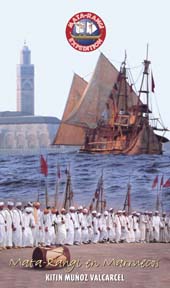
Mata Rangi III
Built: Kitín Muñoz, Barcelona, Spain; left Barcelona, May, 2001.
Reed Ship (1m) Length 65ft breadth 14ft (21m × 4.5m). Hull: totora reed Compliment: 9 Design: traditional
Kitín Munoz set out from northeastern Spain to traverse the Atlantic in a 65-foot (20-meter) vessel. Munoz and his eight-member crew hope to sail to the Colombian city of Cartagena de Indias. They are trying to prove that long before Christopher Columbus arrived in the Americas local sailors would have been able to cross the Pacific Ocean to Asia in similar boats.
After a first failure on "Ra I", Muñoz' mentor, the famous Norwegian explorer Thor Heyerdahl of the "Kon Tiki" (the balsa boat that crossed the Pacific Ocean from Peru to French Polynesia in 1947) had already rallied Barbados from the Moroccan port of Safi aboard another reedboat, "Ra II", in 57 days, in 1970.
"Our expedition will demonstrate the capability of this type of boats, built with to traditional techniques and materials, to cross oceans", Kitín Muñoz explained. He also aims at demonstrating that ancient peoples could realize intercontinental voyages on the seas.
But, as Heyerdahl already proved the capability of such a transatlantic trip for such boats, Muñoz wants to go further: "The main objective of this trip is to prove the resistance of the boat and to get over the mark of five months of navigation in a boat with such characteristics."
The Mata Rangi III left Barcelona on May 6th and has stopped at several ports of the Mediterranean Sea including Valencia, Alicante, Cartagena, Malaga, and Cadiz in Spain.
One month after departing from Sidi Ifni and after a total of 8 months of sea trials, the longest a reed ship has survived afloat, the ship arrived at the end of January 2002 in Cape Verde, where, after being received by the president of the republic, the expedition was terminated.
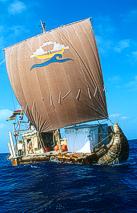
Abora II
Built: Dominique Goerlitz, Hautajata, Bolivia; 2002.
Reed Ship (1m) Length 39.4ft breadth 14.4ft depth 12ft (11.5m × 4.4m × 3.8m). Hull: totora reed Comp: 12 Des: traditional
On May 17th 2002 ABORA 2 started with an international crew from Alexandria (Egypt), sailing a back and forth journey across the Mediterranean Sea. The route was from Alexandria to Beirut, then to Cyprus, and then back to Alexandria for a total distance of approximately 2150 kilometers (1100 nautical miles) within 61 days.
The main aim of the expedition was to demonstrate the full sailing capabilities of prehistoric vessels. Consequently all Mediterranean civilizations could be within regular contact of each other by sea. The practical proof of this navigational performance would supply new evidences for the importance of the prehistoric navigation in the development of the first civilizations in the Old World.
The boat was built in Bolivia and shipped over to Europe where it was rebuilt for the launch in Alexandria. With a crew of nine, including nationals from Germany, Egypt, Norway and Bolivia, Goerlitz and his team aim to prove that people from Asia Minor, before the age of Phoenicians, managed to conquer the seas and that these people reached Atlantic territories around 3000BC.
Following in the footsteps of Norwegian scientist Thor Heyerdahl, Goerlitz hopes to prove the links between prehistoric communities in Asia Minor and the Americas. Heyerdahl used models of Pharaonic boats to build two papyrus crafts, the Ra II and the Tigris, which succeeded in crossing the Atlantic and the Indian Ocean respectively. His expeditions called into question the notion that Columbus was the first transatlantic navigator and demonstrated how the ancient Sumerians could have traveled widely.
Goerlitz wanted to take the studies a step further and open possibilities of Mediterranean civilizations having influence on the New World. This was not possible under Heyerdahl's expedition because he had sailed with the currents, being unable to maneuver his boat against the wind.
Görlitz, SCHILFBOOT ABORA
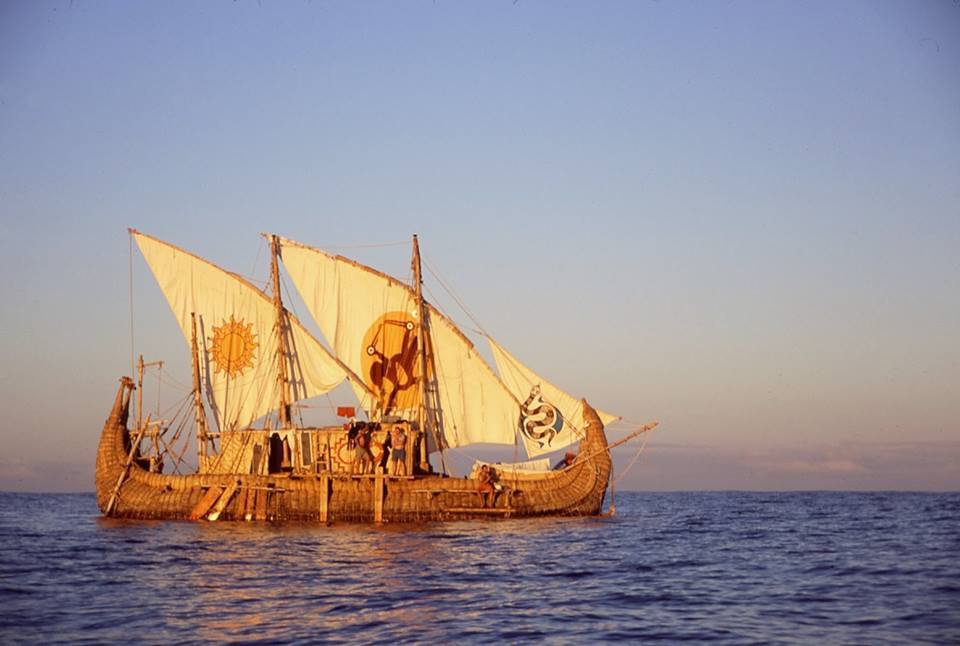
Built: Phil Buck, Valparaiso, Chile; 2003.
Reed Ship (1m) Length 55ft breadth 16ft (16.5m × 4.9m). Hull: totora reed Compliment: 9 Design: traditional
The Viricocha made the world's first successful reed-boat voyage in 2000 from Chile to Easter Island, a 2,850-mile stretch and the trip was hailed a scientific breakthrough by the late Thor Heyerdahl, the Norwegian explorer whose famous 1947 "Kon-Tiki" expedition aboard a balsa raft inspired the Viracocha adventure.
Besides satisfying an appetite for adventure, Phil Buck hoped to promote a scientific theory that pre-Incan cultures were capable of navigating the high seas on similar reed boats and may have colonized Easter Island and other parts of Polynesia. The Viracocha II, was scheduled to begin construction on Easter Island the following November, and sail 8,000 nautical miles from there past Tahiti, to Cairns, Australia, starting in the spring of 2002.
March 17,2003 was the day the Viracocha II finally left Vina del Mar, Chile to begin the planned voyage to Sydney, Australia. The reed ship Viracocha II reached Easter Island after 75 days at sea (more than twice the anticipated time), in desperate condition - the crew was out of cooking fuel and low on food, the boat was dramatically lifted to one side (the side that was not beaten during the launch), the steering mechanism bad been rebuilt three times and was still failing, and the hull had sunk nearly 3 feet (50 percent). The captain and crew decided it would be unsafe to attempt to sail beyond Easter Island, and so the expedition halted, covering less than 25 percent of its intended route.
NATIONAL GEOGRAPHIC ADVENTURE
April 2004, Volume 6, Number 3
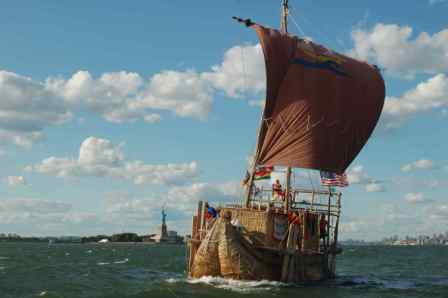
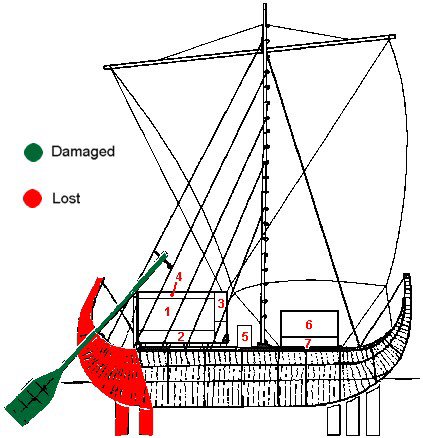
Abora III, click for full page
Built Dominique Gorlitz, Huatajata,Bolivia
Reed ship, Length 32.8ft (10m)
ABORA III is the prehistoric style vessel intended to sail across the North-Atlantic from New York, USA to Pontevedra, Spain. Built entirely from reeds and rope, the hull is constructed by the Aymara-Indians on the shores of Lake Titicaca, Bolivia. The German biologist leading the expedition, Dominique Goerlitz, argues that traces of cocaine and nicotine found a few years ago in the stomach of the ancient Egyptian pharaoh, Ramses II, were native to the Americas, so must have travelled to Africa by sea. He says he is also hoping to overturn current thinking that says the prevailing Atlantic winds would have allowed ancient mariners to sail west to the Americas, but would have prevented them from returning home.
Abora III made substantial progress towards the Azores but after the stern of the boat was destroyed in a storm, the vessel had to be abandoned.

Kota Mama and the Scientific Exploration Society
Expedition Phase I Desaguadero River
Builder: John Blashford-Snell, Hautajata, Bolivia;
Flotilla of reed boats from Lake Titicaca to Lake Poopo along the Desaguadero River. 1998
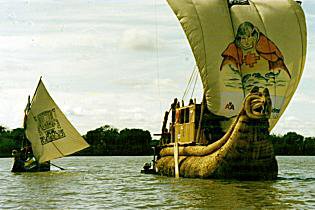
Kota Mama II Puerto Suares (Bolivia) to Buenos Aires
Built: John Blashford-Snell, Hautajata, Bolivia;1999.
Reed Ship (1m) Length 44ft (13.5m). Hull: totora reed Compliment: 9 Design: traditional
How did traces of both cocaine and nicotine find its way to ancient mummies in Egypt when these substances were native to only South America during the time of the pharoahs? Could a shipwreck full of Roman amphorae found off the coast of Brazil be evidence of cross Atlantic trading?
From Puerto Quijarro at the foothills of the Andes to Buenos Aires in Argentina, the Kota Mama expedition's reed boats sailed over 2,770 kilometers in a quest to prove the existence of early trading links between South America and Africa. A 50-member team moved down the Rio Paraguay carrying out archaeological and ethnographic surveys, wildlife conservation programs and community aid projects in Bolivia, Paraguay, Argentina and Brazil. Both boats used in the expedition survived the journey proving that similar voyages could have been undertaken hundreds of years ago.
Blashford-Snell, KOTA MAMA: FROM THE ANDES TO THE ATLANTIC
Headline Book Publishing ©2000
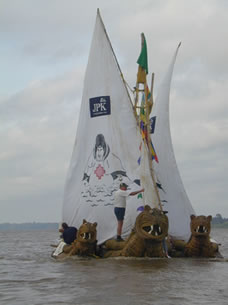
Kota Mama phase III
Builder: John Blashford-Snell, Hautajata, Bolivia;
A 4,000 km voyage in traditional boats from the Andes to the Atlantic via the Amazon. The expedition began with the team sailing from the Inca gold mines on the Rio Mapiri. The expedition members then proceeded through a 500 km stretch of rapids and falls between Bolivia and Brazil. Few craft have travelled this hazardous stretch of water in recent years. However, it is believed that early civilisations were able to negotiate these terrifying cataracts. The expedition members successfully proved that it was possible for reed boats to negotiate through these difficult waters.

Built: Tom Vosner, Oman
Ship Length 13 metres or 42.6 ft. Hull: totora reed coated in bitumen
Built in the form of a traditional "U" shaped hull i.e. similar to the way the Marsh Arabs built their small skiffs, a patchwork of reeds
over "U" shaped reed bundles then coated with bitumen. Sailed in February 2000 destination India but was soon swamped by the seas.
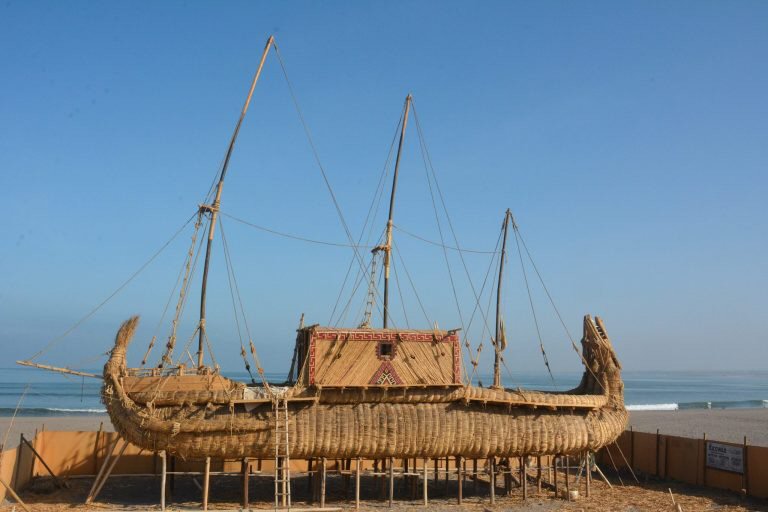
Built: Phil Buck, la Paz, Bolivia
Reed Ship Length 18 metres or 60 ft. Hull: totora reed, Design: traditional
Viracocha III transported by road to Chinchorro Beach, Arica, Chile for transoceanic crossing to Australia departing in February 2019.
Arrived Tahiti July 2019.

Fig. 1. traditional reed boats in Lake Titicaca

Fig. 2. reeds boats and handicrafts in Lake Titicaca
Construction process
How do we build a totora reed boat?
The technique used for building a reed boat in the area of Lake Titicaca is the most ancient, and it is also very effective for navigation because it has remained constant and well defined in its operation resulting in a consistently stable craft.
The reed boat comprises two individual hulls or cylindrical cores which are bound together by attachment to a smaller central core using a single continuous rope in a spiral fashion thus forming a single united hull from the component reed cylinders.

Fig. 3. principles of reed boat construction

Fig. 4. gathering the totora reeds in Lake Titicaca

Fig. 5. typical instruments, hooks and pounding stone.

Fig. 6. Preparing the longitudinal cores.


Fig. 7. compacting the reeds with a stone.


Fig. 8. working on the hulls.


Fig. 9. left, the basic hulls without the bulwark, right with the bulwark rolls added.

Fig. 10. an upturned model shows how the two hulls are joined together. The smaller inner cylinder is not seen.

Fig. 11. above, with cloth sail, or propelled by a pole sometimes used as an oar.

Fig. 12. totora reeds in Lake Titicaca
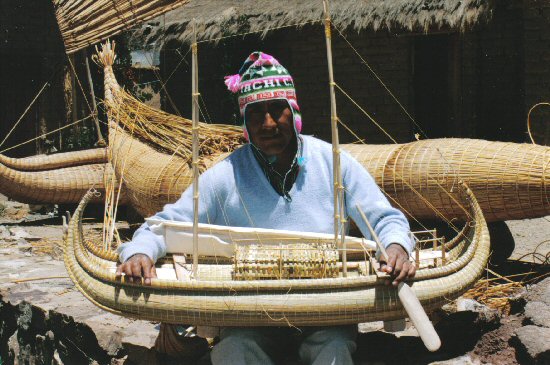
Porfirio Limachi, reed boatbuilder, with experimental model
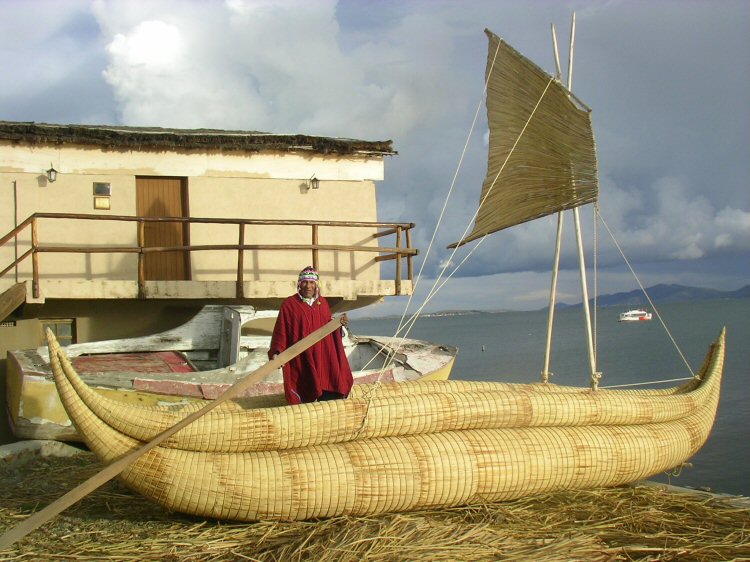
Porfirio Limachi, with traditional reed boat built for export to Korea, 2009.
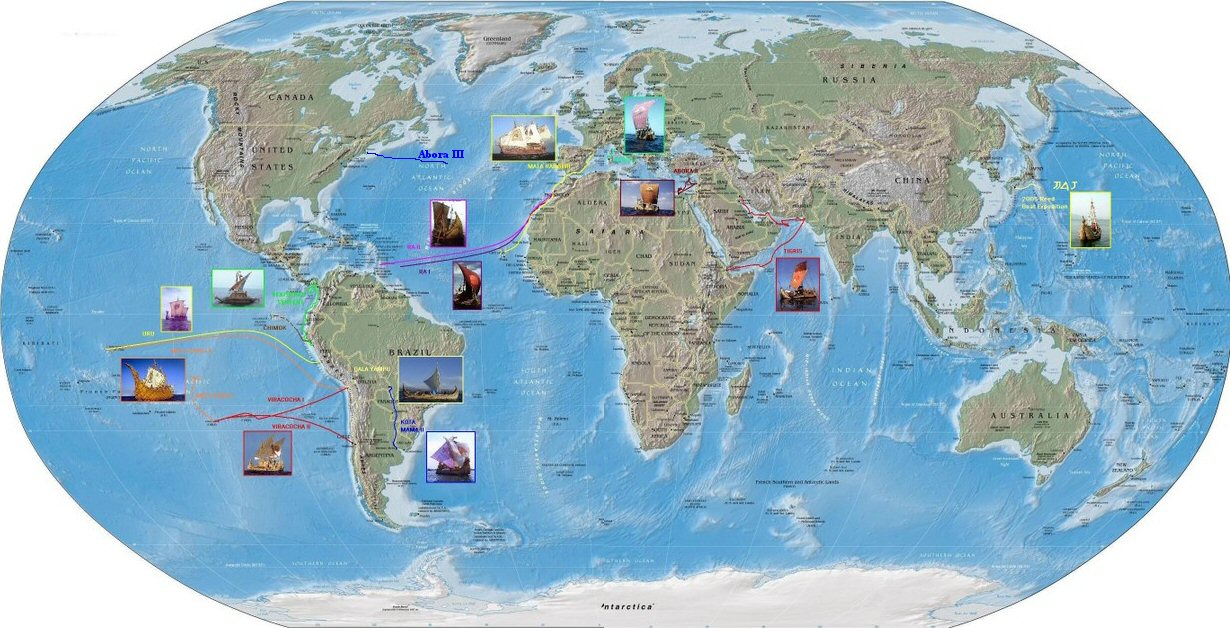

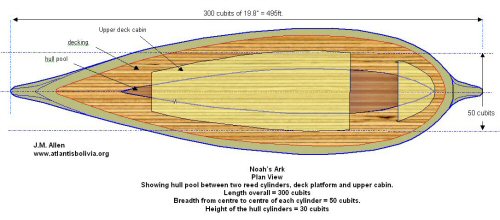 related page: Noah's Ark was a reed ship
related page: Noah's Ark was a reed ship
Updated July 2019
Jim Allen
email webatlantis@hotmail.com

